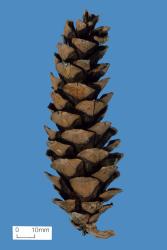- Taxon
- Weed
- Gallery
Small to large tree, pyramidal at least until after maturity, with crown irregular later. Bark smooth, greyish green until fully developed then rough towards base. Shoots brown or greenish brown, usually somewhat puberulent at first, latter glabrous except for tuft of hairs beneath insertion of lf fascicles, sometimes completely glabrous. Buds narrow-ovoid, greenish, not resinous; scales with free acuminate apices. Foliage in dense masses towards branch ends. Lvs 5 per fascicle, 4–13 cm × 0.5–0.7 mm, soft and tending to droop; resin canals marginal; sheaths deciduous by mid-summer. ♂ strobili < 1 cm long, narrow-cylindric. Conelets stalked, cylindric; scales rounded or obtuse. Cone stalks ± recurved, to 2 cm long. Mature cones solitary, deciduous, falling intact, 7–16 × 3–5 cm when open, cylindric, ± symmetric but often curved, yellowish brown, somewhat tapering towards apex; scales thin, flexible; apophyses rounded; umbo smooth; scar very resinous. Seed wing narrow, to c. 1.5 cm long.
[From: Webb et al. (1988) Flora of New Zealand. Volume 4.]




